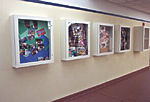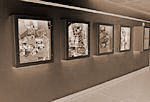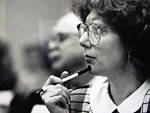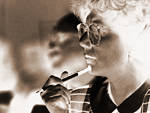




The Museum of the School of Social Work
Shelly Willis
"Trust that art will make things happen about which you will never know, be able to track, evaluate, quantify, or write, but that may return to you in another form, in your own work, in the work of others, in art, and in life."
Mary Jane Jacob, from Words of Wisdom, A Curator's Vade Mecum on Contemporary Art.
Harrell Fletcher isn't a traditional sculptor, muralist or painter. He
doesn't retreat to his studio and appear six months later with an object
to be placed in front of a building or a painting to hang on a wall. You're
likely to find him wandering the streets of a neighborhood, discovering
the beauty of weeds in a sidewalk crack, listening to stories from the
guy who has owned a local rug store for 50 years or unraveling the fears
of a developmentally disabled student. His public art projects allow seemingly
ordinary people to tell their own stories.
"The way I go into a project is by not knowing what we're going to do," he says. "I have some broad ideas about how the art can possibly come across, but don't have any preconceived notions about the issues to address. Instead of saying what's important to the community, I let the people stay it."
Harrell's approach to making public art led to his commission, in the spring of 2000, to create a permanent public artwork for the University of Minnesota's renovated School of Social Work building. More than a year and some struggle later, Fletcher installed his artwork titled, "The Museum of the School of Social Work," throughout three floors of the building.
Although Fletcher
isn't a social worker, much of his art involves interaction with people
and communities. He wanted the artwork for the School of Social Work to
reflect the school's history and future while also requiring participation
among people within the school. In the end, through talks with students
and staff, he developed an interactive museum about the school itself.
The artwork consists of five elements:
- a permanent collection of 100 framed photographs, culled from the school's archive, of people and moments documenting the school's history.
- a library filled with books by artists who focus on the intersection of art and society, which faculty, staff and students can add to over time.
- four display cases given over to a new set of four "student curators" each year in a rotating exhibition. Using the library as a resource for text, images and various artifacts, these students determine content for the cases by articulating what they want visitors, faculty and staff to know about their work at the school or life.
- a high-resolution flat screen showcasing digital images of people Fletcher encounters as he goes about his work and life. He plans to submit new images every six months for the next 10 years.
- a web site, archiving the above, updated through the course of the 10-year project. www.harrellfletcher.com/sosw/harrellgallery/soo1/2001.html
The day the photographs were delivered to the school's lobby for installation, staff and faculty shuffled around the photographs, recalling people and events depicted in the images. The school's assistant director was so moved by the work she suggested creating a brochure to document the stories behind the images.
The finished public artwork is a sharp detour from Fletcher's initial proposal - to install a triptych of screens in the school's lobby that would continuously show photographs of his work over the next 10 years. The committee that selected Fletcher was generally enthusiastic about the project, appreciating the ever-changing quality of the artwork and use of technology. Two members of the committee, though, questioned whether Fletcher's proposal was art, at all. Members wanted Fletcher to spend more time studying the school and its people before delivering his proposal, and there were concerns about the physical and technical maintenance of a piece expected to last at least 50 years.
Fletcher took the input in stride, adding the library and permanent artworks to the project and purchasing a warranty for the high-resolution flat screen, to counter concerns regarding the life of the piece. The committee's desire to participate in and document the school's history inspired Fletcher to minimize his participation and increase the presence of faculty and staff in the project, resulting in a framework for them to contribute and make things about the work that they do. Fletcher says he wants the community to have more control than simply vetoing an artists work and says the strength of public art rests in dialog and interaction, and the audience wondering instead of just knowing.
The course of this project, from selecting an artist to the installation of finished work, is at once unique and universal to public art. Every project is different, nothing goes as planned. There are standard mechanisms for choosing and contracting artists, reviewing designs and installing and maintaining public art. Yet these mechanisms need to remain flexible and organic. Artists have been experimenting, investigating and moving around in public spaces in new ways since the 1960's, so no matter how carefully public art projects are conceived, planned and executed, there are unexpected challenges along the way.
Through it all, it's important to trust that an artwork will impact people in ways no one, not even the artist, can foresee. With all the excitement surrounding Fletcher's project now, it's impossible to say whether staff and students years from now will embrace it with the same enthusiasm. Even Fletcher can't know where he will derive his inspiration five and 10 years from now.
Funding for the School of Social Work project ($37,000), as with most of the University of Minnesota's public art projects, comes from the State of Minnesota, which passed legislation recommending 1 percent of construction costs for state buildings be used for art.
The University of
Minnesota's public art program is administered by university staff at
the Weisman Art Museum. The program is overseen by a Public Art on Campus
Committee, comprised of faculty and staff from the College of Architecture
and Landscape Architecture, Art, Art History, Art and Facilities Management
Departments, and chaired by the Director of the Weisman Art Museum. The
committee advises on program policy, procedure and development and approves
all public art on campus. Representatives from the committee serve on
all public art selection committees, which also include members of the
community in which the artwork will go. In the case of the Fletcher public
art project, members of the faculty and staff from the School of Social
Work and two members of the Public Art on Campus Committee selected and
guided Fletcher through the design, fabrication and installation phases
of the project.